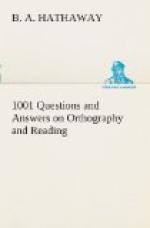139. What does San signify?
The person who, as partisan, etc.
140. What does Ship signify?
The condition, as professorship.
141. What does Some signify?
Full, as quarrelsome.
142. What does Ster signify?
The person who, as teamster.
143. What does Teen signify?
Ten to be added, as fourteen.
144. What is the signification of Tude?
The state of being, as similitude.
145. What does Ty signify?
To multiply into, as seventy, forty, etc.
146. What does Ude signify?
Same as Tude, the state of being.
147. What does Ule signify?
Little, as globule.
148. What does Ward signify?
Direction of, as eastward, etc.
149. What does Ways signify?
Manner, as crossways, lengthways, etc.
150. What does the suffix Y signify?
Plenty, as smoky; also abounding in, as
wealthy.
151. Are there any exceptions to the
meaning of the foregoing
Prefixes
and Postfixes?
There are some, and therefore great judgment
must be exercised in
applying
them to the analysis of words.
152. What is meant by the term “Good
Bye"?
God be with you.
153. What does the suffix Ster signify?
Feminine, as spinster.
PROMISCUOUS QUESTIONS.
1. Is A the first letter of all written
alphabets?
All but one, the Abyssinian.
2. What number is A in the Abyssinian
alphabet?
The thirteenth.
3. Is double A ever written together
as a word?
It is, as a proper noun.
4. What is Aa the name of?
About forty small rivers in Europe.—Cyclopedia.
5. Is B the second letter of all alphabets?
All except the Ethiopic.
6. What number is B in the Ethiopic?
Ninth.
7. Give a word in which P has the sound
of B.
Cupboard.
8. What letter is the Sonorous counterpart
of T?
The letter D.—Cyclopedia.
9. Give the Periodic changes of the
English language.
Saxon, Semi-Saxon, Old English, Middle
English, and Modern English.
10. Give date of “Saxon period."
Previous to 1150 A.D.
11. Give date of “Semi-Saxon
period."
1150 to 1250.
12. Give date of “Old English
period."
1250 to 1350.
13. Give date of “Middle English
period."
1350 to 1550.
14. Give date of “Modern English
period."
Time since 1550.
15. What constitutes a Period in Language?
Any great change in the Literature of
a People.




